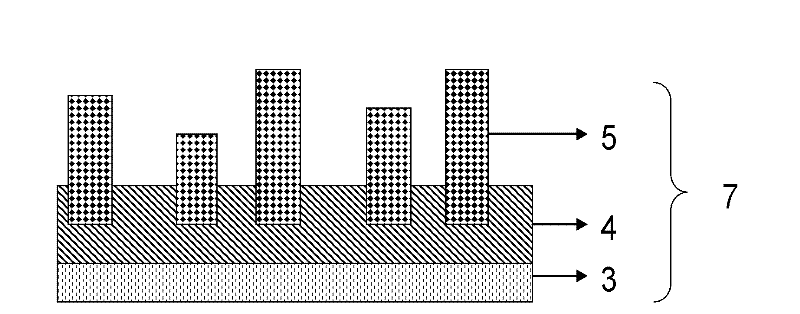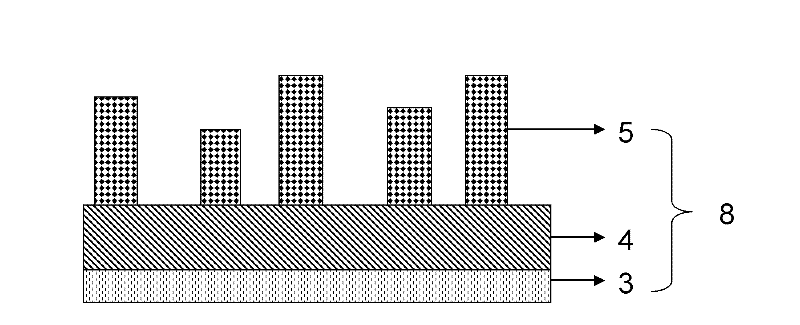An organic semiconductor micro-nanocrystalline array, a preparation method thereof and application thereof in a photovoltaic cell
A technology of organic semiconductors and organic semiconductor layers, which is applied in semiconductor/solid-state device manufacturing, photovoltaic power generation, semiconductor devices, etc., and can solve problems such as low mobility, inability to be widely used in practical applications, short-circuit of thin-film devices, etc.
- Summary
- Abstract
- Description
- Claims
- Application Information
AI Technical Summary
Problems solved by technology
Method used
Image
Examples
Embodiment 1
[0121] The preparation method of the organic semiconductor micro-nano crystal array of the present invention
[0122] (I) if figure 1 The method for making the first organic semiconductor micro-nano crystal array 6 of the present invention shown is as follows:
[0123] (1) The substrate is indium tin oxide (ITO) glass, and the root mean square roughness (RMS) of the surface of the substrate used is less than 1nm, so it does not need to be smooth and can be used directly; or, the root mean square roughness (RMS) of the substrate surface ) greater than 1nm, the substrate is smoothed with an aqueous dispersion (PEDOT:PSS) of poly(3,4-ethylenedioxythiophene) poly(styrene sulfonate);
[0124] (2) vacuum-depositing the induction layer 3 on the surface of the substrate or the smoothed substrate;
[0125] The material of the induction layer 3 is P4T or BP2T, and the thickness is not less than 2 nanometers and not more than 12 nanometers;
[0126] (3) Vacuum deposition of an organic...
Embodiment 2
[0170] First structure of the present invention (as Figure 13 Shown) the preparation method of the photovoltaic cell containing organic semiconductor micro-nano crystal array is as follows:
[0171] (1) The substrate is ITO glass, and the root mean square roughness (RMS) of the substrate surface used is less than 1nm, so it does not need to be smoothed and used directly; or, the root mean square roughness (RMS) of the substrate surface is greater than 1nm, and PEDOT is used :PSS smoothing;
[0172] (2) Vacuum deposit an induction layer 3 on the surface of the substrate; the thickness of the induction layer 3 is not less than 2 nanometers and not more than 12 nanometers, and the material is BP2T or P4T;
[0173] (3) Vacuum deposit organic semiconductor micro-nano crystal layer 5 on the surface of induction layer 3, induction layer 3 and organic semiconductor micro-nano crystal layer 5 form micro-nano crystal array 6; The height of nanocrystalline grains is not less than 5 na...
Embodiment 3
[0190] The second method of making photovoltaic cells containing organic semiconductor micro-nano crystal arrays of the present invention is as follows:
[0191] (1) The substrate is ITO glass, and the root mean square roughness (RMS) of the surface of the substrate used is less than 1nm, so it does not need to be smoothed, and it can be used directly; or, the root mean square roughness (RMS) of the substrate surface is greater than 1nm, use PEDOT :PSS smoothing;
[0192] (2) Vacuum deposit an induction layer 3 on the surface of the substrate; the thickness of the induction layer 3 is not less than 2 nanometers and not more than 12 nanometers, and the material is BP2T;
[0193] (3) p-type organic semiconductor layer 4 with a thickness of m is vacuum-deposited on the surface of induction layer 3, then vacuum co-deposited p-type organic semiconductor layer 4 and organic semiconductor micro-nano crystal layer 5, the organic semiconductor layer 4 of co-deposition The thickness is...
PUM
| Property | Measurement | Unit |
|---|---|---|
| Thickness | aaaaa | aaaaa |
| Thickness | aaaaa | aaaaa |
| Thickness | aaaaa | aaaaa |
Abstract
Description
Claims
Application Information
 Login to View More
Login to View More - R&D
- Intellectual Property
- Life Sciences
- Materials
- Tech Scout
- Unparalleled Data Quality
- Higher Quality Content
- 60% Fewer Hallucinations
Browse by: Latest US Patents, China's latest patents, Technical Efficacy Thesaurus, Application Domain, Technology Topic, Popular Technical Reports.
© 2025 PatSnap. All rights reserved.Legal|Privacy policy|Modern Slavery Act Transparency Statement|Sitemap|About US| Contact US: help@patsnap.com



